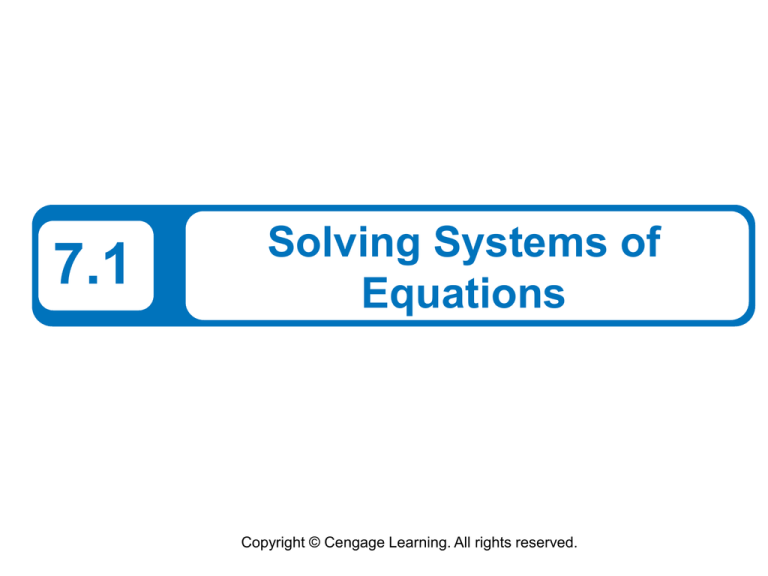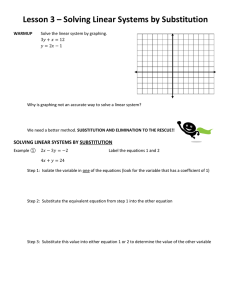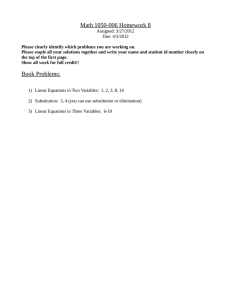
7.1
Solving Systems of
Equations
Copyright © Cengage Learning. All rights reserved.
What You Should Learn
•
•
•
Use the methods of substitution and graphing to
solve systems of equations in two variables
Use systems of equations to model and solve
real-life problems
You probably do not need to take many notes
for 7.1, maybe only the two red sentences on
slides 5 and 13 (but you do need to read the
entire thing). More is fine.
2
The Methods of Substitution
and Graphing
3
The Methods of Substitution and Graphing
So far in this text, most problems have involved either a
function of one variable or a single equation in two
variables. However, many problems in science, business,
and engineering involve two or more equations in two or
more variables.
To solve such problems, you need to find solutions of
systems of equations. Here is an example of a system of
two equations in two unknowns, x and y.
Equation 1
Equation 2
4
The Methods of Substitution and Graphing
A solution of this system is an ordered pair that satisfies
each equation in the system. Finding the set of all such
solutions is called solving the system of equations. For
instance, the ordered pair (2, 1) is a solution of this system.
To check this, you can substitute 2 for x and 1 for y in each
equation.
5
The Methods of Substitution and Graphing
In this section, we will study two ways to solve systems of
equations, beginning with the method of substitution.
6
The Methods of Substitution and Graphing
When using the method of graphing, note that the
solution of the system corresponds to the point(s) of
intersection of the graphs.
7
Example 1 – Solving a System of Equations
Solve the system of equations.
Equation 1
Equation 2
Solution:
Begin by solving for y in Equation 1.
y=4–x
Solve for in Equation 1.
Next, substitute this expression for y into Equation 2 and
solve the resulting single-variable equation for x.
x–y=2
Write Equation 2.
8
Example 1 – Solution
x – (4 – x) = 2
Substitute 4 – x for y.
x–4+x=2
Distributive Property
2x – 4 = 2
Combine like terms.
2x = 6
Add 4 to each side.
x=3
cont’d
Divide each side by 2.
Finally, you can solve for by back-substituting x = 3 into the
equation y = 4 – x to obtain
y=4–x
Write revised Equation 1.
9
Example 1 – Solution
y=4–3
Substitute 3 for x.
y = 1.
Solve for y.
cont’d
The solution is the ordered pair (3, 1).
Check this as follows.
Check (3, 1) in Equation 1:
x+y=4
Write Equation 1.
3+1
Substitute for x and y
4
4=4
Solution checks in Equation 1. ✓
10
Example 1 – Solution
cont’d
Check (3, 1) in Equation 2:
x–y=2
Write Equation 2.
3–1
Substitute for x and y.
2
2=2
Solution checks in Equation 2. ✓
Because (3, 1) satisfies both equations in the system, it is a
solution of the system of equations.
11
Application
12
Application
The total cost C of producing x units of a product typically
has two components: the initial cost and the cost per unit.
When enough units have been sold so that the total
revenue R equals the total cost C, the sales are said to
have reached the break-even point.
You will find that the break-even point corresponds to the
point of intersection of the cost and revenue curves.
13
Example 6 – Break-Even Analysis
A small business invests $10,000 in equipment to produce
a new soft drink. Each bottle of the soft drink costs $0.65 to
produce and is sold for $1.20. How many bottles must be
sold before the business breaks even?
Solution:
The total cost of producing x bottles is
C = 0.65x + 10,000.
Equation 1
14
Example 6 – Solution
cont’d
The revenue obtained by selling x bottles is
R = 1.20x.
Equation 2
Because the break-even point occurs when R = C, you
have
C = 1.20x
and the system of equations to solve is
15
Example 6 – Solution
Now you can solve by substitution.
C = 0.65x + 10,000
cont’d
Write Equation 1.
1.20x = 0.65x + 10,000
Substitute 1.20 for C.
0.55x = 10,000
Subtract 0.65 from each side.
x 18,182 bottles.
Use a calculator.
16
Example 6 – Solution
cont’d
Note in Figure 7.8 that revenue less than the break-even
point corresponds to an overall loss, whereas revenue
greater than the break-even point corresponds to a profit.
Verify the break-even point using the intersect feature or
the zoom and trace features of a graphing utility.
Figure 7.8
17



